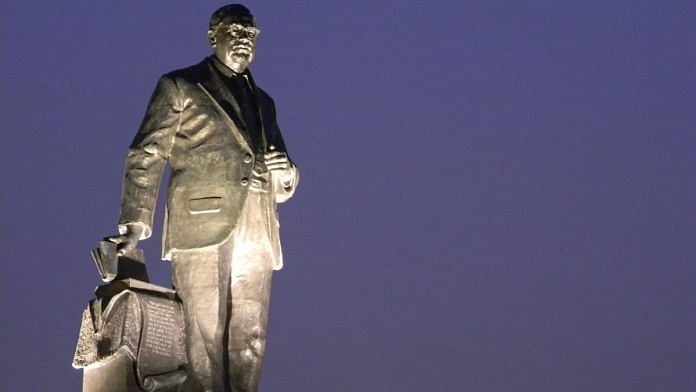Dr BR Ambedkar, one of the biggest intellect and social reformers of the 20th century, allegedly burnt the Manava Dharmasastra or Manusmriti on 25 December 1929. He was one of the major critiques of Hinduism and later adopted Buddhism as his religion.
Ambedkar’s critique of Hinduism stems from the caste system. Caste is a social hierarchy that divides people into four main groups. At the top of the pyramid are the Brahmins or the priest group, who are considered most intelligent by Hindu texts. As per the texts, only Brahmins only have the right to education. Next to them are the Kshatriyas or the warrior clan who serve in the army and are kings. The third category is Vaishyas. Their occupation is mainly agriculture, cattle rearing, trade and business pursuits.
The lowest in the caste hierarchy are the Shudras. They are the ones who have to ‘serve’ the upper castes. The last group, which are excluded from the Brahmanical varna system, are the Dalits or ‘Untouchables’. They are the ones who have to carry the burden of the caste pyramid and are considered slaves by the upper castes. Note that I am talking about ‘varna’ not caste. There is a difference between them. Varna is a brahminical division whereas caste or jati is where a person is born. I have used ‘caste’ here but I mean ‘varna’.
Also read: Parsis in Baroda berated Ambedkar for his caste. But Naval Bhathena changed everything
Hindu scriptures and the caste system
The notion of caste hierarchy can be traced back to the Hindu scriptures. The most prominent Hindu scripture that advocates the doctrines of the caste system is the Manusmriti. The Manusmriti or the Manava Dharmasastra is believed to be the first legal text and constitution of the Sanatan Dharma.
I want to present a few of the verses of this scripture that will highlight my argument:
“For the welfare of humanity the supreme creator Brahma, gave birth to the Brahmins from his mouth, the Kshatriyas from his shoulders, the Vaishyas from the thighs and Sudras from his feet.”- Manu’s code – I-31
“He must never read the Vedas in the presence of the Shudras.”- Manu – IV 99
“A Brahmina who is only a Brahman by decent, one has neither studied nor performed any other act required by the Vedas may, at the king’s pleasure, interpret the law to him, act as the judge, but never a Shudra.”(however learned he may be).- Manu VIII 20
“Any Brahmin, who enslaves or tries to enslave a Brahmin, is liable for a penalty of no less than 600 panas. A Brahmin can order a Shudra to serve him without any remuneration because the Shudra is created by Brahma to serve the Brahmans. Even if a Brahman frees a Shudra continues to be a slave as he is created for slavery. Nobody has the right to free him.”- Manu VIII-50, 56 and 59
“If a Shudra arrogantly presumes to preach religion to Brahmins, the king shall have poured burning oil in his mouth are ears.”- Manu VIII 272
These verses are examples of how Brahminism wants to rule the other, the so-called lower castes, by using the name of God. The scripture also dehumanises women and treats them as mere objects. The following verses show the sexist outlook of the scripture:
“She who disrespects to (a husband) who is addicted to (some evil) passion, is a drunkard, or diseased, shall be deserted for three months(and be) deprived of her ornaments and furniture.”- Manu 9:78
“Wise men should never marry women who do not have marry women who do not have a brother and whose parents are not socially well known.”- Manu 3:10
“Wise men should marry only women who are free from bodily defects, with beautiful names, grace/gait like an elephant, moderate hair on the head and body, soft limbs and small teeth.”- Manu 3:11
It is pretty lucid that the Manusmriti is a scripture that advocates inequality in terms of caste and gender. The Vedas or the four main scriptures of Hinduism, too mention the caste system.
Many Hindu apologists try to make a point that the caste is not hereditary rather it is based on the innate qualities of man, and texts like Manusmriti came afterwards in Hinduism through Brahamincal rulers. Well that’s not true. The Vedic scriptures do point out that caste is hereditary. The Chhandogya Upanishads 5.10.7 states, “Those whose conduct has been good here will shortly get birth such as Brahmana (Brahamana yonim), a kshatriya, or a Vaishya. But those whose conduct has been evil will be born in evil births shortly such as the birth of a dog (shva yonim), or as a pig, or a chandala.”
The verse implies that varna is decided by birth, and not due to the qualities one possess. It is clear that Hindu scriptures uphold ideas of one being born into one’s position within the societal framework, and have to follow its dictates.
The author is a student at Ryan International School, Greater Noida. Views are personal.




